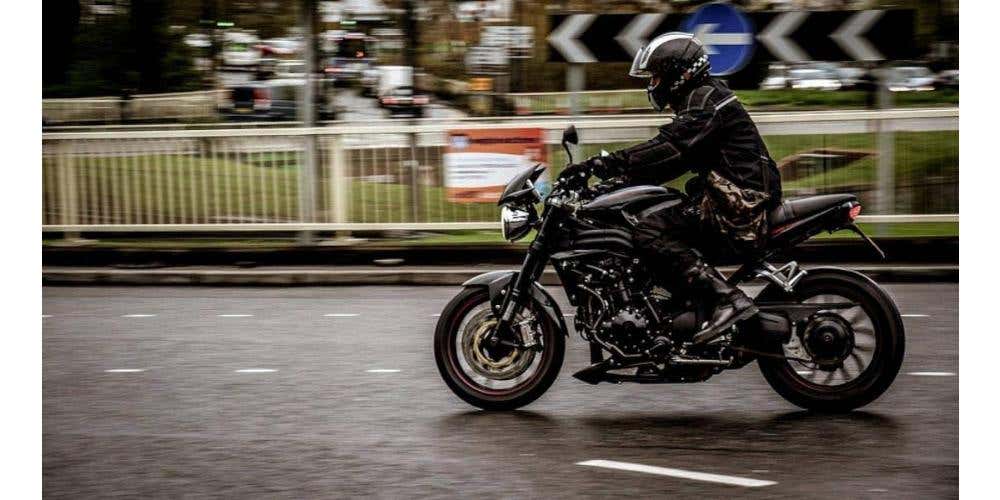





It's a fact of life for the UK biker; you're going to get rained on at some point no matter how hard you might try to avoid it. Whether it's a short sharp shower or just some drizzle it's hard to overstate what a negative experience this can be if you're unprepared. With the speed of a motorcycle you'll find the water forces its way in incredibly quickly, and you become cold and miserable within moments. Not only is it an unhappy situation, it can be a dangerous one as your extremeties will soon start to get cold and stiffen leading to poor fine control of the brakes, throttle and clutch - all while you're less able to see through a water droplet covered visor!
Of course, the solution here is to get waterproof gear. This can come in a great many forms, and you'll find waterproofing in pretty much all styles of gear in some form, whether that be a leather jacket or a pair of denim jeans. For sheer waterproofing capability textiles are still the ones to beat, but don't underestimate the lowly waterproof overs as a stopgap solution.
If you've ever needed to look at waterproof gear before you'll know it's a minefield. The number of different, but similar technologies in play here are astounding, with a lot of manufacturers having their own membranes or other tech to keep the water at bay, so which do you go for? Hopefully this guide will make things at least a little clearer.


Waterproofing used to be a basic affair - things like waxed cotton were basically all you had, but nowadays there are membranes of all kinds now. The most famous, and arguably the most capable, membrane of them all is Goretex. Used in all sorts of gear Goretex is a membrane that has one fundamental advantage over basic waterproofing; it allows water vapour to escape and keeps water out. If you've ever used a full set of basic waterproofs when it's not freezing cold you'll have experienced the sweat-box effect. All that water vapour from your body trying to keep regulate its temperature has nowhere to go, leading to lovely puddles forming if it's warm enough! Goretex goes some way to prevent this, increasing breathability markedly.
Of course it's no longer a simple 'this gear has Goretex, therefore it should have some of the best waterproofing' - it's been developed further. The original Goretex was a fragile membrane that had to sit below the outer layers of the gear. Not so anymore with laminated Goretex. It costs more (what new tech doesn't?) but it has a massive advantage over the old school membrane - the outside of your gear no longer gets soaked. This used to be an issue as your gear would become way heavier and take forever to dry, as well as running the risk of starting to smell. Laminated Goretex keeps the water out of all layers of your gear keeping everything light and dry. There's also a new Surround Goretex tech found in boots which uses soles with small perforations to allow breathability via the entire sole of the boot - you don't even normally get this on vented summer boots!


If you're after laminated Goretex then textiles are your avenue - jackets and trousers from Bering, Spidi, Dainese and Rukka, to name but a few, have started to include the tech so you're spoilt for choice. You will generally pay a premium for gear including this lamination over the conventional membrane, so it's a feature you'll need to carefully consider. The Dainese Antarctica jacket is a great example of what can be achieved with a waterproof textile jacket - armour throughout, extremely abrasion resistant, massive closable air vents, removable thermally insulating jacket and fully covered in laminated Goretex. It could work in summer or the dead of winter and keep all the elements at bay.


Looking at the more conventional waterproofing solutions we come onto the normal waterproofing offered by Goretex, and each brand's own solutions that they've developed either by themselves, or in partnership with chemical and tech firms. Dainese's D-dry, RST's SinAqua, Alpinestars Drystar and Spidi's H2Out are great examples of this, with slightly differing feature sets. They all work on the principle of being waterproof and breathable membranes, with some of them even managing to be windproof, although it's fair to say other windproof layers can be implemented. You also have the bog standard 'waterproof' specification - this will be waterproof but offer no breathability, maybe this will work for you, especially if your budget is tight.


The other thing to consider is whether you want the jacket to be waterproof all the time. No matter how breathable a membrane is it will never match a mesh jacket for example. A waterproof liner (which can include breathable tech) can sometimes be the better option, rather than a full waterproofing solution. Leather jackets, inherently not waterproof, can benefit hugely from this model of waterproofing as it can mean you can stick out that shower without either having to hide under a bridge or get soaked through. The other option here is to carry a set of waterproof overs with you - if you've the space to carry them they can be a great compromise for summer riding, providing you're content to put up with the faff of putting them on if you think it'll rain.
Like us on Facebook, follow us on Instagram and Twitter, subscribe to our mailing list to keep up to date on the latest gear, and events happening at Bike Stop throughout the year. Drop by to have a chat about riding in the local area, or anywhere else, have a delicious coffee and a cake, or check out our range of the latest gear.





